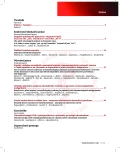Delayed donor reactions to blood donations – anonymous electronic survey
Authors:
P. Papoušek 1; Z. Kráľovská 1; T. Suchý 2; R. Procházková 1,3
Authors‘ workplace:
Transfuzní oddělení, Krajská nemocnice Liberec, a. s.
1; Oddělení kompozitních a uhlíkových materiálů, Ústav struktury a mechaniky hornin,
Akademie věd České republiky, Praha
2; Fakulta zdravotnických studií, Technická univerzita v Liberci
3
Published in:
Transfuze Hematol. dnes,24, 2018, No. 1, p. 46-52.
Category:
Original Papers
Overview
Background:
The incidence of undesirable delayed blood donation reactions that appear only after leaving a donation centre (off-site) are not as methodically monitored as early reactions. In this study, their frequency was determined using the simple and inexpensive method of an electronic survey.
Materials and methods:
The studied population included voluntary and non-remunerated donors who gave whole blood as well as apheresis donors at the Regional Hospital Liberec over the previous 12 months. 5497 were contacted via a short mobile phone text message with a link to an anonymous electronic questionnaire located on the Regional Hospital Liberec website. Donors reported any complaints or symptoms related only to their last donation.
Results:
1 792 questionnaires were used in the definitive analysis (32.6% of all contacted donors). The average age of the donors was 38.5 years. One complication was present in 35.3% donors (26.8% males and 46.7% females, p < 0.001). The most frequent complaints included fatigue (21.2%); haematoma at the site of puncture (13.1%); weakness, faintness and dizziness (5.30%); pain of the limb from which blood was collected (4.80%); shortness of breath on exertion (3.46%); symptoms of infection (cold, elevated temperature, muscle and joint pains, chills) over the seven post-donation days (2.01%); delayed venipuncture bleeding (1.51%); phlebitis (0.61%); nausea and vomiting (0.45%); collapse (0.45%) and unconsciousness (0.33%). The adverse reactions occurre more frequently after whole blood donation (36.8%) than after plasmapheresis (24.4%), p < 0.001. Tired male donors ran a 17 times higher risk of weakness or dizziness than non-tired donors (p < 0.001), and tired women donors also had a 2.5 times higher risk of weakness or dizziness than non-tired female donors (p < 0.001).
Conclusion:
More than 1/3 of donors, predominantly women, reported some problems after donations. Fatigue was the dominant complaint among these. The study provided detailed data for designing educational material for donors.
Key words:
adverse delayed reaction – blood donation – electronic survey
Sources
1. Standard for Surveillance of Complications Related to Blood Donation Working Group on Donor Vigilance of the International Society of Blood Transfusion, December 11, 2014. [online 19.3.2017]. Dostupné na www: http://www.aabb.org/research/hemovigilance/Documents/Donor-Standard-Definitions.pdf.
2. Newman BH, Pichette S, Pichette D, Dzaka E. Adverse effects in blood donors after whole-blood donation: a study of 1000 blood donors interviewed 3 weeks after whole-blood donation. Transfusion 2003;43:598–603.
3. Eder AF, Hillyer CD, Dy BA, et al. Adverse reactions to allogeneic whole blood donation by 16- and 17-year-olds. JAMA 2008;299:2279–2286.
4. Wiltbank TB, Giordano GF, Kamel H, et al. Faint and prefaint reactions in whole-blood donors: an analysis of predonation measurements and their predictive value. Transfusion 2008;48:1799–1808.
5. Kamel H, Tomasulo P, Bravo M, et al. Delayed adverse reactions to blood donation. Transfusion 2010;50:556–565.
6. Bravo M, Kamel H, Custer B, Tomasulo P. Factors associated with fainting – before, during and after whole blood donation. Vox Sang 2011;101:303–312.
7. Narbey D, Fillet AM, Jbilou S, Tiberghien P, Djoudi R. Case-control study of immediate and delayed vasovagal reactions in blood donors. Vox Sang 2016;111:257–265.
8. Custer B, Rios JA, Schlumpf K, Kakaiya RM, Gottschall JL, Wright DJ. NHLBI Retrovirus Epidemiology Donor Study-II (REDS-II). Adverse reactions and other factors that impact subsequent blood donation visits. Transfusion 2012;52:118–126.
9. Preacher, KJ. Calculation for the chi-square test: An interactive calculation tool for chi-square tests of goodness of fit and independence [Computer software]. 2001 [online 5.1.2017–11.2.2017]. Dostupné na www: http://quantpsy.org.
10. Goldman M, Osmond L, Yi QL, Cameron-Choi K, O‘Brien SF. Frequency and risk factors for donor reactions in an anonymous blood donor survey. Transfusion 2013;53:1979–1984.
11. Wiersum-Osselton JC, Marijt-van der Kreek T, Brand A, Veldhuizen I, van der Bom JG, de Kort W. Risk factors for complications in donors at first and repeat whole blood donation: a cohort study with assessment of the impact on donor return. Blood Transfus 2014;12;Suppl 1:s28–33.
12. Morand C, Coudurier N, Rolland C, et al. Prevention of syncopal-type reactions after whole blood donation: a cluster-randomized trial assessing hydration and muscle tension exercise. Transfusion 2016;56:2412–2421.
13. Takanashi M, Odajima T, Aota S, et al. Risk factor analysis of vasovagal reaction from blood donation. Transfus Apher Sci 2012;47:319–325.
14. Ditto B, France CR. Vasovagal symptoms mediate the relationship between predonation anxiety and subsequent blood donation in female volunteers. Transfusion 2006;46:1006–1010.
Labels
Haematology Internal medicine Clinical oncologyArticle was published in
Transfusion and Haematology Today

2018 Issue 1
Most read in this issue
- Delayed donor reactions to blood donations – anonymous electronic survey
- Inherited thrombocytopenias
- Use of central venous catheters in haematological patients and associated infections: overview of the situation in the Czech and Slovak Republics and recommendations for prevention and diagnosis
- Chronic benign CD8+ lymphoproliferation in a patient after rituximab treatment
